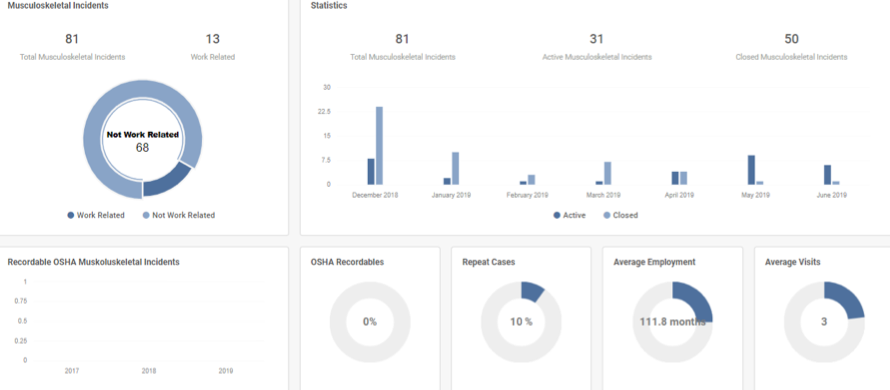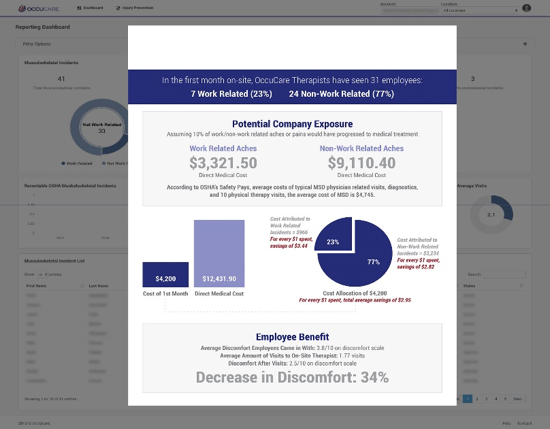I have enjoyed the last 23 years of working with employers to eliminate their work-related injuries. The joy I see on an employees face when you are able to take an early sign or symptom of a work related musculoskeletal disorder and eliminate that minor injury within a week or two is what drives me to continue to work with employers in implementing quality programs to reduce their work related injuries and illnesses.
Historically there have been some interesting trends. During the crash of 2008 my co-workers and I at OccuCare saw companies eliminate musculoskeletal injury prevention programs. These prevention programs were the first to go as companies were looking to reduce expenses. OccuCare had a significant number of successful companies that continued to utilize our services, so we were able to weather the storm.
In 2014 through 2016 the economy began to pick up again and in the last few years has surged so companies globally looked to implement new and improved musculoskeletal injury prevention programs. The trend during this phase was companies wanted analytics. OccuCare's customers wanted continuous metrics that included some of the following items.
Instant return on investment
Chief Financial Officers wanted a monthly report that showed a continuous return on investment
Work-related incidents versus non work-related incidents
Safety and HR wanted to know the percentage of employees being seen for work related incidents versus employees seeing the on-site therapist for non-work-related injuries
Visit trends
Employers wanted to know how many visits on average it took to eliminate the work related or non-work-related symptoms
Summary of the week's visits
Employers wanted to know what was happening behind closed doors to get their employees healthy
Employee satisfaction survey
Employers wanted to know if the employees were satisfied with the service being provided
This trend brought about OccuCare Injury Prevention designing our own software documentation system that immediately provides this and many other data analytics to our customers.

OccuCare Software statistics

OccuCare return-on-investment statistics
Since 2019, we are seeing companies eliminating their Post Offer Employment Testing and opting for Post Offer Placement Testing. The pool of employees is shrinking with all of the jobs available out in the market and many employers need to hire every employee who applies for a job. This has brought about the age of new employee work hardening and catapulted injury prevention programs to the forefront of employer's injury elimination initiatives.
New employee work hardening is a method many employers are implementing to tackle the ergonomic risk factor of unaccustomed work activity injuries. When an employee's body is not accustomed to the physical requirements of the job, an employer can opt to design a transition to full duty regimen that allows the employee to gradually improve their physical abilities to allow them to perform the repetition or weight the job duties require. An employer requires ADAAA compliant job descriptions with jobs classified into categories of difficulty. Then a Pre-Employment Post Offer Placement test is performed on new hires and employee are placed into jobs that they can physically perform for a few weeks. Then after few weeks of employment the employee moves up a difficulty category to the next level of jobs. They continue this on-site work hardening approach until the employee is able to perform at the highest physically demanding level. There is not one standard approach and each company requires a thorough analysis to determine the appropriate time frame to fully accomplish this strategy.
Injury prevention is exploding across the country. Many employers are realizing the value an on-site Occupational Health Therapist lends to their goal of zero injuries. A company's highest financial burden associated with work related injures is due to musculoskeletal injuries. Physical Therapists, Occupational Therapists and Athletic Trainers are specifically trained as high as doctoral level of training to specifically understand how to evaluate and treat every work-related musculoskeletal injury that could occur at a worksite.
These on-site Occupational Health Therapists work within the OSHA first aid guidelines and are able to keep 50% to 75% of work related minor musculoskeletal incidents from becoming OSHA recordables which in turn reduces a company's injury cost by 50% to 75% as well.
For every $1.00 spent a typical OccuCare customer saves $3.00 to $5.00 when our services are implemented.
I have been working on-site at employers since the mid 1990's. Never hesitate in calling me at OccuCare Injury Prevention to see how I can help your company reduce their OSHA recordables by 50% to 75% immediately.
Jim Mecham, MSIE, OTR/L, CPE is co-owner of OccuCare Injury Prevention services and has worked with employers all over the world implementing strategies that significantly reduce work related musculoskeletal injuries. Reach out at 833-858-9946 or email him at jmecham@occucare.net.